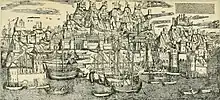Siege of Aden
The siege of Aden occurred when the Portuguese Governor of India, Afonso de Albuquerque, launched an unsuccessful expedition to capture Aden on 26 March 1513.
| Siege of Aden | |||||||
|---|---|---|---|---|---|---|---|
 Assault on Aden in 1513, by Gaspar Correia | |||||||
| |||||||
| Belligerents | |||||||
| Yemeni Tahirids | |||||||
| Commanders and leaders | |||||||
| Afonso de Albuquerque | Amîr Morjan[1] | ||||||
| Strength | |||||||
|
20 ships 1,700 Portuguese 800 Malabar natives | Unknown | ||||||
| Casualties and losses | |||||||
| 100 or 200 killed.[2] |
50 killed.[3] 39 pieces of ordnance captured | ||||||
Background
Aden was an independent city-state whose strategic location allowed it to control the entrance of the Red Sea.[4][5] It became a wealthy trading area due to its location at the crossroads of busy trade routes into the Red Sea.[4] Albuquerque's plan to capture Aden would allow him to dominate the Red Sea and strike a military blow at Mamluk Egypt. Aden was one of four strategic places that Albuquerque wanted to capture: Aden – to control the straits of Mecca (Red Sea); Hormuz – to control the straits of Basra (the Persian Gulf); and Diu and Goa – to ensure sovereignty of all the other districts of India.[6]
Siege

Albuquerque's fleet sailed from Goa, India, on 18 February 1513, and consisted of 20 ships manned by 1,700 Portuguese and 800 allied natives of Malabar.[7] The fleet arrived at Socotra Island. The captains deliberated on how to approach Aden. Some of Albuquerque's chiefs suggested an attempt at negotiated surrender while others pressed for an immediate attack. Albuquerque chose the latter option, believing that negotiations would give the inhabitants time to strengthen their defences or obtain reinforcements from elsewhere.[6] Before dawn on Easter Sunday (26 March), the Portuguese commandeered some landing barges in the harbour, ferried their men ashore, and began their siege on Aden.[6] They captured an outwork, where many defenders were slain and 39 pieces of ordnance were captured. However, they were later repulsed and suffered high casualties.[1] The overall attack failed, with the scaling ladders collapsing under the weight of the men trying to mount them. This left some of the Portuguese trapped in isolation atop the wall.[6] According to Albuquerque's biographer son, the attack was abandoned after all their scaling ladders broke.[5] By midday, Albuquerque and his men withdrew to their ships.[6] After plundering and burning the vessels in the harbour, and cannonading the town, the fleet sailed towards the Red Sea.[1]
Aftermath
Albuquerque stated: "I think that if I had reconnoitred Aden first, I would not have launched our attack where I did."[8] The failure to capture Aden significantly undermined his strategy. Without a base of operations at the mouth of the Red Sea, it was impossible for the Portuguese to prevent spices being shipped to Egypt and the Mediterranean by the traditional route. The Crown's ability to enforce a trade monopoly in the Indian Ocean had been fatally damaged.[5] Alarmed by the Portuguese threat, the Egyptian Mamluks occupied the Yemeni Tihamah and attempted to capture Aden but failed. The Portuguese launched a second attack but also failed. Aden finally fell in 1538 to Suleiman Pasha, the commander of a large Ottoman fleet. Under Ottoman control, Aden was valued primarily as a barrier to European penetration of the holy cities rather than as an entrepôt for trade.[9]
References
- Hunter, F. M. (1877). An Account of the British Settlement of Aden in Arabia. London: Trübner & Co. p. 162.
- R.B.Serjeant, The Portuguese Off the South Arabian Coast: Ḥaḍramī Chronicles, with Yemeni and European Accounts of Dutch Pirates Off Mocha in the Seventeenth Century, 1963, Clarendon Press, p. 47
- R.B.Serjeant p. 47
- Fritze, Ronald H. (2002). New Worlds: The Great Voyages of Discovery, 1400-1600. Gloucestershire: Sutton. p. 191. ISBN 0-7509-2346-6.
- Newitt, Malyn (2005). A History of Portuguese Overseas Expansion, 1400–1668. London: Routledge. pp. 81–82. ISBN 0-415-23979-6.
- Peters, F. E. (1994). Mecca: A Literary History of the Muslim Holy Land. Princeton: Princeton University Press. pp. 180–182. ISBN 978-0-691-65415-7.
- Vogel, Theodore (1877). A Century of Discovery: Biographical Sketches of the Portuguese and Spanish Navigators from Prince Henry to Pizarro. London: Seeley, Jackson, & Halliday. p. 125.
- Crowley, Roger (2015). Conquerors: How Portugal Seized the Indian Ocean and Forged the First Global Empire. New York: Random House. p. 292. ISBN 978-0-8129-9400-1.
- Dumper, Michael R. T., ed; Stanley, Bruce E., ed. (2007). Cities of the Middle East and North Africa: A Historical Encyclopedia. Santa Barbara, California: ABC-CLIO. p. 11. ISBN 978-1-57607-919-5.